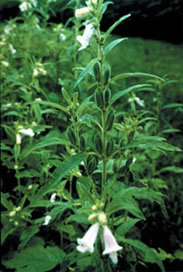Sesame

Sesame (til) an oilseed crop, Sesamum indicum of the family Pedaliaceae, locally known as til. From ancient times, sesame is being cultivated in the Indian subcontinent and in China. The plants may attain a height of about one metre, usually with side branches. In Bangladesh it is grown in almost all districts but grows well in greater Khulna, Faridpur, Pabna, Barisal, Rajshahi, Jessore, Comilla, Dhaka, Rangpur, Sylhet, and Mymensingh districts. It is the second major oil-producing crop in the country.
Hairy leaves of sesame plant are serrated and deep green. Flowers are white and rose-coloured. Fruits are generally four or more chambered capsules. Each plant produces 50 to 70 capsules and there may be 55 to 70 seeds in each capsule. The black or brown coloured seeds mature in 90 to 100 days. Seeds contain 42-45% oil and 20% protein. Average sesame yield in Bangladesh is about 957 kg per ha. Currently, about 38,923 ha of land are under sesame cultivation and annual production is about 37,260 m tons. Sesame is cultivated in both kharif and autumn seasons, but two-third sesame is produced in kharif season. High land with sandy loam is best suited for sesame cultivation.

In the field, sesame plants are infested by a number of insect pests. The notable pests are the Til-hawk moth (Acherontia styx) and hairy caterpillar (Spilosoma obliqua). A mirid bug Cyrtopeltis sp. also causes considerable damage.
Sesame oil is a quality edible oil. The oil is tasteless, odourless and also used as hair oil and as a component of cosmetics. The seed is used in making various food items like cakes, khaja, biscuits, etc. Dry plants and leaves are used as fuel and oilcakes as cattlefeed. India and China are the major sesame producing countries. Nowadays its cultivation is expanding in some parts of Africa and America. [Md Mukbil Hossain]
